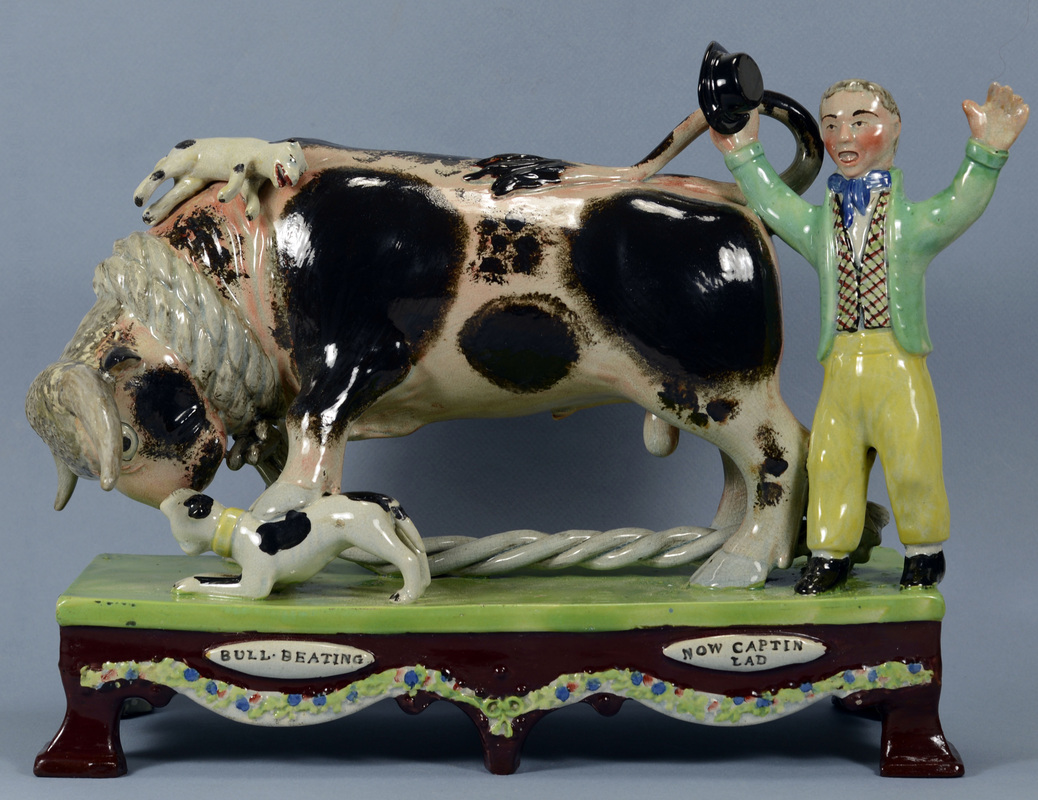What do we make of the bull baiting below? Actually, it too is "Sherratt". No marbled table base here. Instead, we have a brown table base with heavy clawed feet, and this base is a distinctive "Sherratt" feature.
- The dog on each base is from the same molds
- The bases are the same size on the top
- The floral swags on the aprons of the base are from the same molds.
Let's focus for a moment on the "Sherratt" brown clawed base. You will not see it on the many figure groups that we can date from their subject matter to post-1827. I have concluded that the brown clawed base is an early "Sherratt" base that was displaced by other designs--in particular the marbled table base-- as the years rolled on. So if the brown clawed base is early and the marbled table base is later, it seems that "Sherratt" made two quite different bull baiting groups over a number of years.
Last month, I was thrilled to discover a "Sherratt" bull baiting group that fits right in between the two extremes we have just looked at. Call it a hybrid of sorts. It has some of the features of both groups.
This group is very like the marbled base group in that it has the same BULL BEATING and NOW CAPTIN LAD title plaques. Also, the base (including the feet) is of the same shape.
What of the smaller dog atop the two earlier bull baitings? That little dog seems to have been abandoned. Interestingly, I have found him on this bull baiting.
One other point: I have seen the two titled "Sherratt" bull baiting models( the marbled base and the brown table base) side by side, and I am still reeling. I have always thought the traditional marble-base group to be over-the-top fantastic, and it is. But wait till you see the brown table base example. OMG! The base may be the same size, but all else is larger. The man is significantly bigger, as is the bull. Even the rope is chunky rather than puny. The bull's coat colors are just glorious, and the man is so life-like that you almost want to pick him up off the base. Add blazingly stunning enamels, and it is enough to make any collector swoon. (My thanks to the generous collector for this photo, but, frankly, it just doesn't do the group justice!) By the way, notice how the bull has his paw atop the dog in the earlier model. It really adds oomph to this very vigorous, gutsy composition
Fun Discovery.
I assisted the collector who bought the bull baiting on the titled brown table base. It was bought sight unseen, based on a condition report that had probably been compiled with the assistance of a black light. Black lights in inexperienced hands are notorious for misinterpreting and missing issues. In this case, the black light had done an excellent job of pointing out what seemed to be restoration. The restoration was exactly where I expected it to be on a bull baiting group: both bulls horns and ears, the dogs tails, the projecting legs on the top dog, the man's hand, and the feet of the table base. Things that stick out invite damage. If you want a perhaps-unique group like this, be prepared to suck up some restoration. Here all the important elements were intact. I told the collector that if I could have changed one thing, I would have wanted the man's raised hand to be original. That hand is so focal....but collecting is all about compromising.
Stay with me...the story goes on. When this group got to the restorer, the collector had a pleasant surprise. The restoration was far LESS than the black light indicated. An amateur restorer had restored one horn and ear. Because he had difficulty matching the color to the original horn and ear, he simply painted both the new color!! Removing that paint revealed the original horn and ear, as good as the day they were made. Very best of all, the man's raised hand was original: three chipped finger tips had been 'restored' with a new coat of paint to the entire hand. The black light had detected the new paint--stripping it off revealed the hand in all its glory. Similarly, the restoration to the dogs was less than expected (for example a tail tip on the larger dog rather than the whole tail and part of the back, as a black light suggested), and only two of the six feet of the base were replaced. Collectors who buy sight unseen and not from a top dealer seldom have pleasant surprises....but there is a first time for everything.
Removing dirt was the best part of the whole restoration process. This figure group had two centuries of black grease on it. Every nook and cranny was coated.






















